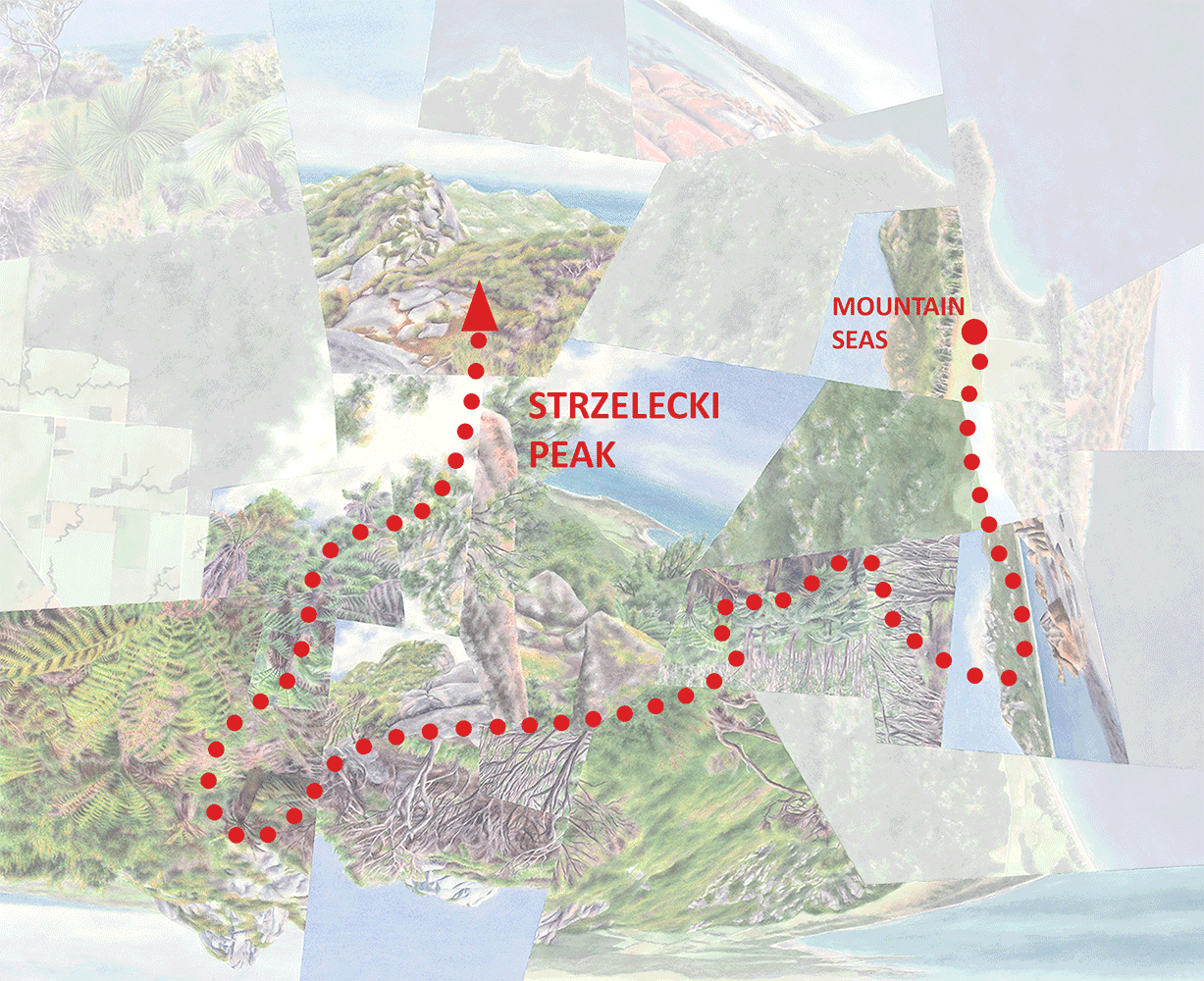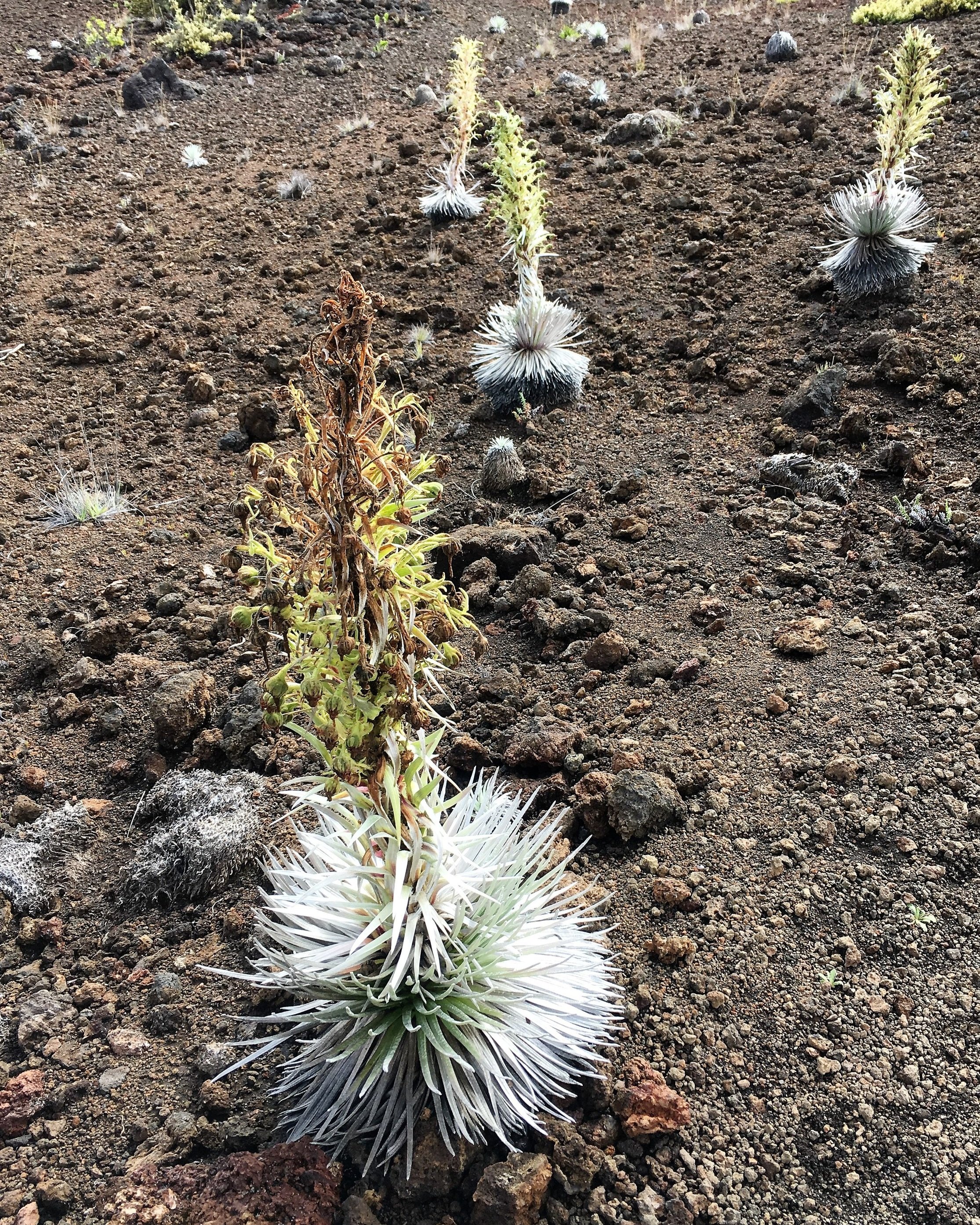East Maui and Haleakala Crater.
Summit, my recently-completed watercolor map inspired by Haleakala Crater on Maui, is one of three works that I discussed in my October 2022 talk— In & On, Around & Above: Mapping Island Experiences—at the Annual Meeting of the North American Cartographic Information Society (NACIS). All of my worldviews are about conveying the intrinsically spatial experiences of islands of various forms, and this talk focused specifically on how this one and the other two, Oasis and Crystallize, capture insularity or “island-ness” in different ways. One consistent challenge was balancing perspectives of the island itself and of the surrounding environment, immersing the viewer on or “in” the island while at the same time emphasizing the island’s contrast with the world beyond. Since the interior of Haleakala Crater—an island in both an ecological and geological sense (that also just happens to be situated on an “actual” oceanic island)—is physically walled off from the exterior in most places, Summit involves a unique relationship between these components of immersion and contrast.
Probably 99% of visitors to Haleakala visit only the highest part of the rim—the “actual” summit (of Maui)—but a network of trails into and across the crater that typically takes three days and two nights (camping, or in cabins with advance reservations) to hike in full provides access to the interior. I did this trek back in 2016.
Haleakala Crater, enlarged.
At around 10,000’ above sea level most of the crater interior is alpine desert; this barren-ness combined with the clusters of cinder cones (the “crater” is in fact a caldera filled with many small craters) produces the feeling of being on a different planet.
Cinder cones near the center of the crater.
Endangered silverswords, unique to the alpine desert of Haleakala.
Parts of the northeastern side of the crater and crater rim, toward Maui’s windward side, have a less lunar character, with pockets native cloud forest vegetation that elsewhere on Maui only persist in inaccessible places. To the sense of the crater as a separate, special world unto itself, this element of ecological diversity adds the quality of being an “entire” world as well.
Native cloud forest vegetation at the crater’s eastern edge.
The lush eastern rim of the crater.
Inside the crater, the sense of being contained with a special, hidden world is of course reinforced by the crater rim—or, by the clouds that often hide or sit above it.
The two large gaps in the rim do give some hint of a world beyond, though at least when I was there the views were still mostly obstructed by clouds.
Early morning view through the Ko’olau Gap.
Looking along the eastern edge of the Kaupo Gap.
The rim itself is accessible only on eastern side at points along the access road, and clear, open views of the wider world are really only available from the main visitor area at the highest point. So it’s only from here that the striking contrast between two “worlds” is apparent—intensified by a kind of topographical illusion. I suspect I’m not the only person who finds it hard to believe that, thanks to the relative gentleness of shield volcano slopes, the summits of Maui and the Big Island are as high as the upper parts of the Sierra Nevada. The juxtaposition of the alpine landscapes of the Haleakala summit and crater with the lowlands of Maui beyond seems all the more dramatic as a result.
View westward from the Maui summit.
This particular view looking south from the summit cuts out middle ground (the outer slopes of the volcano) completely, so that the ocean looks as if it were only a few hundred feet below. (In the distance are the peaks of Mauna Kea and Mauna Loa on the Big Island.)
Traveling through the more familiar landscapes of the Maui lowlands, the special world of the crater is similarly out of sight and out of mind.
Semi-native rainforest along the trail to Waimoku Falls, in the coastal section of Haleakala National Park.
Looking at Haleakala from the coast, not only is the crater physically invisible; as with the impression standing on the summit, the gradual slopes make it hard to believe that the mountaintop is above the tree line.
In the initial digital mockup for the watercolor map, the form of the crater—and therefore the sense of immersion within and of contrast with the world beyond—doesn’t read very well. The problem is a combination of too many fragments and a lack of uniformity of light and color between them.
The watercolor would need to focus more on the crater itself (eliminating a few of the views from beyond) and call more attention to the rim by evening out the colors and playing with the shadows. (Interestingly the “horizon lines” of the gaps in the rim read as continuations of the rim itself, which would help to emphasize the sense of enclosure.)
I’m pretty happy with the outcome (below), but since my visit predated this current style of map, I’d really like to return and be more deliberate about collecting imagery. (Fortunately I took plenty of photos the first time, but there were some missing pieces that I ended up filling with google imagery or eliminating with compositional distortions.) In fact the National Parks Arts Foundation offers a paid artist residency in this (and other) national parks that I have been trying for…hopefully someday I’ll get lucky.
Darren
Summit, watercolor on paper, 39”x52.”
Summit detail, desert zone.
Summit detail, rainforest zone.


































